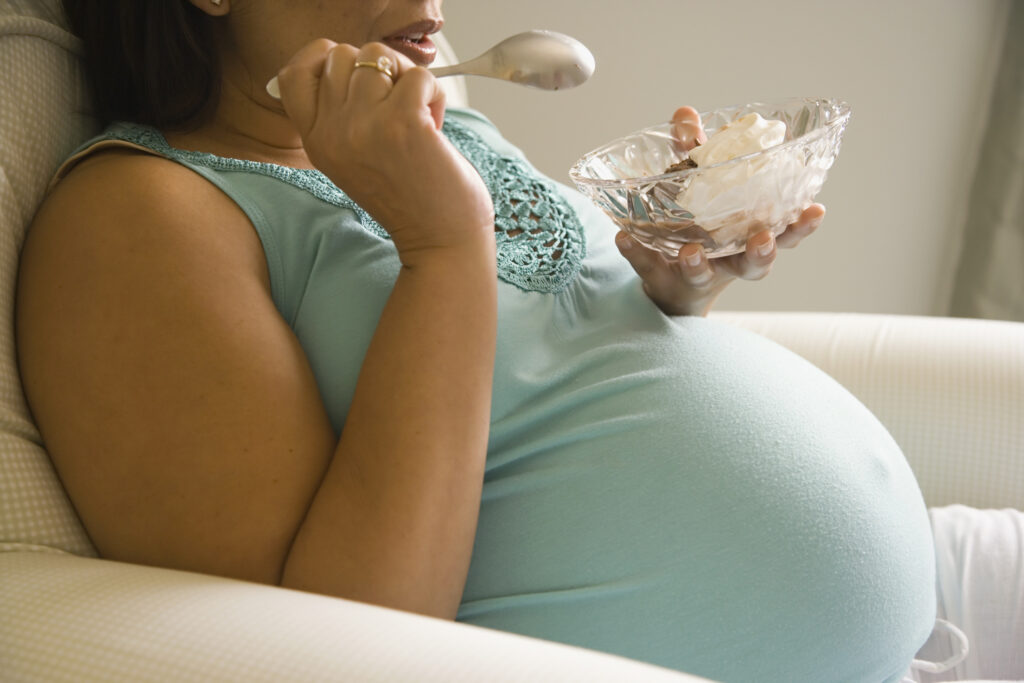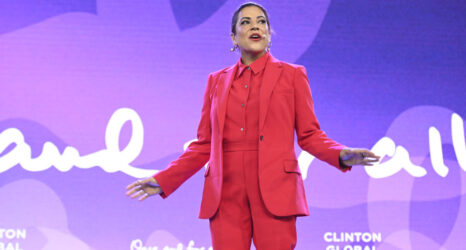For pregnant women, it can feel like every food is suspect, and every meal fraught. Society expects sacrificial motherhood—with moral (and sometimes criminal) sanctions for those who fail to comply.

Before getting pregnant, I had only a vague and cinematically informed idea of what the whole thing entailed: a test with two lines on it, occasional bouts of vomiting at inopportune moments, some climactic huffing and puffing in a hospital gown, and, of course, the right to demand ice-cream and pickles at 3 in the morning. Imagine my surprise, then, when I discovered that “eating for two” is an anachronism, a unicorn, a thing from a svelter (or hungrier) past.
Today, with obesity having overtaken undernutrition as a public health concern, women are told—by doctors, magazines, friends, mothers-in-law—to eat “healthy” and watch their diets carefully. They are cautioned what they eat will affect their unborn child. The U.S. Department of Health and Human Services intones: “‘Eating for two’ doesn’t mean eating twice as much. Rather, it means that the foods you eat are the main source of nutrients for your baby.“
It’s twice the responsibility, in other words, not twice the pleasure.
What a responsibility it is—the wrong food or drink can put the baby at risk for everything, from fetal alcohol spectrum disorder, to listeria poisoning, diabetes or “macrosomnia” (aka overly large baby syndrome).
These are scary prospects, so it should come as no surprise that the internet is teeming with forums where women flock to confess to having eaten a tuna melt or kicked back a glass of wine, worried that they may have condemned their unborn to a future of remedial math classes, or worse.
Reassurance is hard to come by, since the only thing consistent regarding pregnant women’s diets is inconsistency.
On the more conservative end of the spectrum, public health agencies may advocate avoiding smoked fish, sushi, soft-ripened cheese, pates of any kind, mayonnaise, alcohol and even caffeine. Many doctors and midwives take a more tempered, “everything in moderation” approach, while some eat as they please without considering the specter of listeria.
But why the uncertainty?
Women flock to confess to having eaten a tuna melt or kicked back a glass of wine, worried that they may have condemned their unborn to a future of remedial math classes, or worse.
Part of the answer is that food-related anxiety in general is on the rise, as consumer options and information sources proliferate. In a sea of possibilities, individuals are left to process different products and ideologies and craft their own coherent eating approach.
But we are exposed to consistently contradictory demands in the process: We are exhorted to “indulge” our cravings, but not to gain too much weight. We are told to “watch what we eat,” but not to fall into compulsive behaviors that could be labeled eating disorders. More than anything else, we are increasingly encouraged to eat “healthy,” but then bombarded with conflicting accounts of what that might look like. Is red wine healthy? Animal fat? Coffee? Kale?
If such choices provoke uncertainty in the general population, they are even more daunting for pregnant women. It’s one thing to make an unhealthy choice for yourself, and another entirely to do so on behalf of your unborn child.
Perhaps it is unsurprising then that today, risk avoidance seems to be the norm when it comes to advising pregnant women on what to eat. Faced with uncertainty about the safety of certain foods during pregnancy, the dominant approach from many doctors and public health agencies is conservative: Why risk it?
The question itself is misleading. It implies that there is definitive risk, when instead there may simply be a lack of evidence that something is safe. This is precisely one of the problems with the precautionary approach to risk management: It requires proof of no harm, rather than no proof of harm. This empirically high bar may be well advised when it comes to, say, a new pharmaceutical product on the market, or environmental pollutants. But when we apply that logic to foods, it creates a situation in which every food is suspect, and every meal fraught.
Pregnant women do “take the risk,” with salami sandwiches and champagne alike, and a standard public health approach to dealing with this fact might be to ask why they do so. Who do we see as at risk? Who is most affected by framing the question in terms of risk to begin with?
We are increasingly encouraged to eat ‘healthy,’ but then bombarded with conflicting accounts of what that might look like.
A precautionary, or risk-averse, approach always has an imperiled subject at the center of its imagination. Children—as key symbols of innocence and future hope—are hardly unexpected risk bearers. Yet thinking of fetuses as children, imbued with personhood, is a relatively new move.
The feminist scholar Joan B. Wolf argues in her book Is Breast Best? that babies (and fetuses, within this expanded threshold of childhood) are understood today as being imperiled by any environment that is less than optimal. That is, anything short of “the best,” is actually construed as a risk factor. Wolf makes this argument by looking at feeding after birth, where the idea of “breast is best” has become so widespread among medical authorities, that the benefits associated with breastfeeding and the disadvantages of formula are exaggerated and misleading. Women are led to believe that a failure to breastfeed will imperil their children, even though the research on the benefits conferred by breastfeeding hardly supports such claims. Even if we accept that breast is best, however, why would we then leap to the conclusion that formula, as second-best, is dangerous?
When it comes to eating during pregnancy, the division isn’t as clear-cut as “breast vs. bottle.” Still, the pressure for mothers to modify their behaviors based on poorly understood risks plays out in the way that women are “educated” about eating.
In a study of information about alcohol consumption given to pregnant women in four northern European countries, a team of researchers led by Anna Leppo found that women were systematically led to believe that there was evidence about the harmful effects of moderate drinking, when in fact there wasn’t. This isn’t just a symptom of living in a risk-averse society—it is a gendered issue. As Leppo and her co-authors point out, “If we practiced the precautionary approach in everything we do, we could do very little and that is what is being asked of pregnant women today.”
In fact, pregnant women in the U.S. and parts of Europe are expected to do quite a lot. They are expected to continue working, providing childcare and doing housework, while being maximally risk-avoidant. Minimizing risk thus isn’t seen as a social obligation—one that could be met by providing clean water, adequate nutrition, paid sick leave and maternity leave—but rather a moral imperative that is placed squarely on the shoulders of the pregnant woman. Considered in this way, that question, why risk it? is rhetorical; there is no way to answer without appearing cavalier or downright immoral.
Minimizing risk isn’t seen as a social obligation … but rather a moral imperative that is placed squarely on the shoulders of the pregnant woman.
The anthropologist Mary Douglas pointed out long ago that risk is always a question of morality. Risk debates, wrote Douglas, “always link some real danger and some disapproved behavior, coding the danger in terms of a threat to a valued institution.” The valued institution, in this case, is what Wolf describes as Total Motherhood: a moral code in which “mothers are exhorted to optimize every dimension of children’s lives beginning in the womb.”
In today’s context, Wolf argues, “good mothering is construed as behavior that reduces even minuscule or poorly understood risks to offspring, regardless of potential cost to the mother.”
This expectation of sacrificial motherhood, and the moral (and sometimes criminal) sanctions for those who fail to comply, offers perhaps the best explanation for why eating while pregnant is a fraught affair. Living for nine months without a particular food or beverage is hardly the most extreme form of deprivation, but the morally tinged anxiety that it produces is neither a hormonal overreaction, nor simply a sign of our anxious times. It reveals, instead, the high-stakes meaning of eating for two in an era of Total Motherhood.
Up next:
U.S. democracy is at a dangerous inflection point—from the demise of abortion rights, to a lack of pay equity and parental leave, to skyrocketing maternal mortality, and attacks on trans health. Left unchecked, these crises will lead to wider gaps in political participation and representation. For 50 years, Ms. has been forging feminist journalism—reporting, rebelling and truth-telling from the front-lines, championing the Equal Rights Amendment, and centering the stories of those most impacted. With all that’s at stake for equality, we are redoubling our commitment for the next 50 years. In turn, we need your help, Support Ms. today with a donation—any amount that is meaningful to you. For as little as $5 each month, you’ll receive the print magazine along with our e-newsletters, action alerts, and invitations to Ms. Studios events and podcasts. We are grateful for your loyalty and ferocity.





